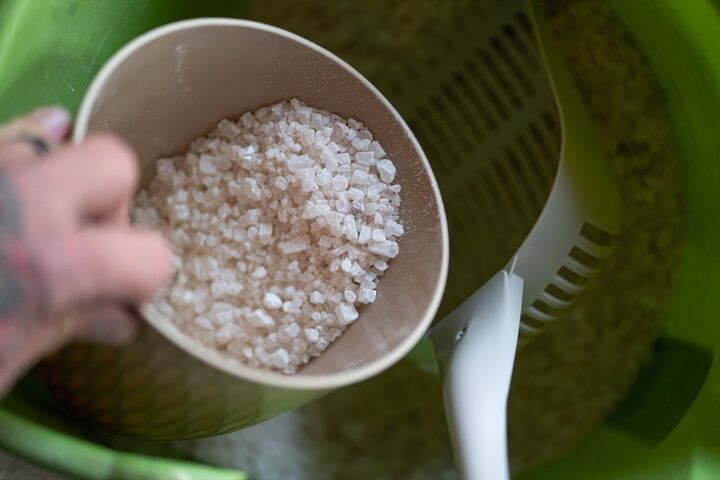Can You Use Water Softener Salt On Your Driveway? (Find Out Now!)

With winter well on its way, those icy driveways and sidewalks are soon to come. Nothing is more frustrating than trying to drive on an icy driveway. You may be tempted to try any type of salt, but not all salts are the same.
You can use water softener salt on your driveway to melt ice. The salt contains the same ingredients as rock salt – namely, potassium chloride and sodium chloride. It is also more affordable. People don’t buy water softener salt very often, so it is usually in stock at a local hardware or home improvement store.
Let’s get into a bit into the science of melting ice with salt, and look at the best way to use these products.
Do You Need Snow Removal Services?
Get free, zero-commitment quotes from pro contractors near you.

What is Water Softener Salt?
A water softener works by removing minerals from hard water to “soften” the water. Hard water contains high levels of calcium and magnesium. Water softener salt beads contain sodium.
When hard water passes through the beads in a mineral chamber, a bit of chemical magic happens. The sodium ions in the water softener beads are replaced by calcium and magnesium. The sodium is released into the water that is now “softened.”
Water Softener Salt vs. Rock Salt vs. Ice Melt
You can use water softener salt to melt ice on a driveway, but you can’t use rock salt to soften water. Why? Because rock salt is not processed to remove impurities. That’s the only difference between water softener salt and rock salt. They both contain sodium chloride or potassium chloride that melts ice.
Ice melt, on the other hand, is entirely different. The grains contain chemicals that melt ice. This is why rock salt is preferred by people who have children and pets. The chemicals in the ice melt dissolve into the water on the surface of the ice. This starts a chemical reaction that heats the liquid and melts the ice.
Why Does Salt Melt Ice?
Here’s a little more winter fun. Why does salt melt ice? The surface of ice has a thin layer of water. When your pour salt on the ice, it mixes with this layer of water. The salty water lowers the freezing point of the ice below it, and this makes even more salty water to melt the ice below that. The process continues until all the ice is gone, and you have some traction on your driveway.
Does Salt Damage a Driveway?
Salt does damage your driveway. It breaks down concrete and asphalt, leaving behind holes and cracks. Use salt sparingly during the winter. Remove as much snow as possible with a shovel or snowblower. Seal the driveway with products that protect against salt damage.
Does Sealing a Driveway Prevent Salt Damage?
A penetrating sealer protects your driveway from moisture. Some sealers also protect the driveway surface against salt. Check the label of the sealer. If it does not specify that it protects against salt damage, apply the sealer. Once the sealer is set, apply a product that is specifically for protection against salt damage.
How to Spread Salt Over Your Driveway
Melting ice with salt takes about 20 minutes, so start early in the morning. Fill a plastic 1-cup scoop with the salt, and spread it by using a side-to-side casting motion. You don’t need to cover the entire driveway. Your tires will get traction in the holes created by the salt. Avoid piling up the salt.
Using Ice Melt on Your Driveway
The advantage of using ice melt on your driveway is that it is safe for concrete and asphalt. If you have pets and children, keep them away from areas where you use ice melt. If your pets or children are outdoors, wipe of their paws, shoes, and hands. Ice melt can be toxic is ingested.
Fill a scoop with ice melt, and cast it side-to-side. Cover the main part of your driveway. Don’t make piles with the ice melt. This slows the melting process.
Household Products That Melt Ice
You can make your own ice melt with common household products. Table salt and sea salt are excellent alternatives. Sprinkle a thin layer over the ice. It may take a bit longer than rock salt.
If you are out of salt, use sugar. Spread it over the ice. Although this is an effective way to melt ice, it is also more expensive. Use only in small areas.
Although it doesn’t work as well as salt, rubbing alcohol does work. It has a freezing point of -20° F. This is another product to use on small areas of your driveway.
Have some compost on hand? Use it to melt ice on your driveway. The urea, ammonium sulfate, and potassium chloride warm the ice. This doesn’t work as quickly as salt or rubbing alcohol, but it is a way to use your compost in the winter.
The last household product that works well on ice is also colorful. Mix beet juice with salt water, and you have yourself a homemade ice melt. Use 20% beet juice and 80% saltwater. This is perfect for areas that are very slippery. Beet juice will stain concrete and asphalt, so rinse the driveway as soon as the temperature is above freezing.
Do You Need Snow Removal Services?
Get free, zero-commitment quotes from pro contractors near you.

Related Questions
Can you use hot water to melt ice on a driveway?
Hot water alone may not melt the ice. Use a combination of 1/2 gallon hot water, 2 ounces of rubbing alcohol, and 6 drops of dish soap.
Does hot water clean frost from windows?
Throwing hot water on a frosty windshield will break the glass. Instead, use one part room temperature water and two parts rubbing alcohol. Put the mixture in a spray bottle, and lightly spray it on your windshield.
Conclusion
When you have ice on your driveway, you need a quick solution. Water softener salt works very well. Use it sparingly. It can damage concrete and asphalt. Ice melt doesn’t damage driveways, but it is toxic, so use it carefully around children and pets. There are also other household products that you can use to melt ice on your driveway.

Jennifer L. Eggerton loves being hands-on, whether it's with a home DIY project, making repairs, re-decorating a room, or keeping life organized. She enjoys helping people by sharing her knowledge, insights, and experiences, as well as her lessons learned. In addition to her work as a writer, Jennifer is a Jeep® overlander, self-published author, and nature photographer who loves being outdoors.
More by Jennifer Eggerton



























